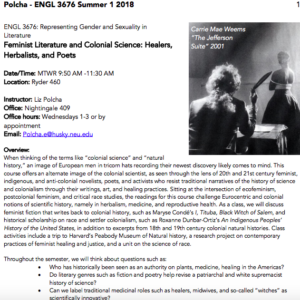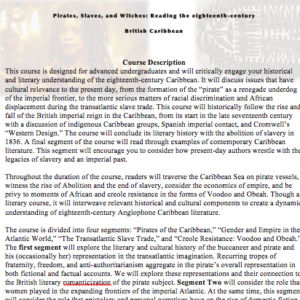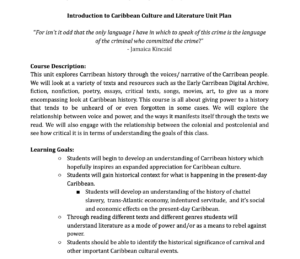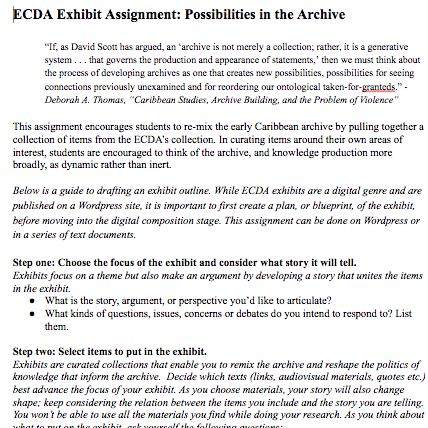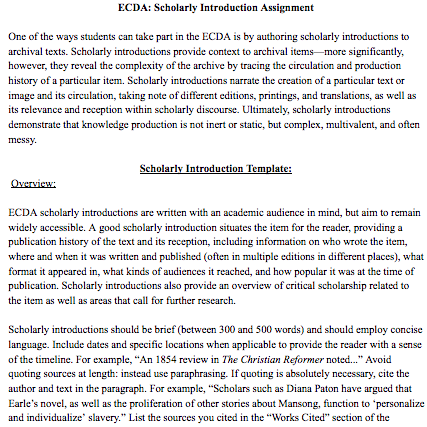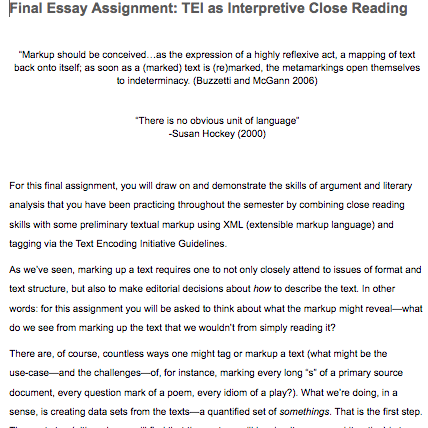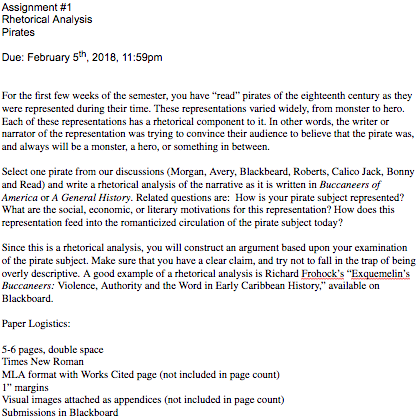Resources for Teachers
Welcome to our resources for teachers! Here, we have included various materials designed to help you use the ECDA in your classroom. Below, you will find links to course syllabi, in-class activities, and assignments. We will update our classroom materials as we continue to collaborate with instructors, so please check back regularly for new teaching resources. Scroll to the bottom if you would like to contribute your own teaching materials via the “Contribute!” button.
Syllabi
Click the images to access PDF copies of the syllabi
Early African American Literature
Nicole N. Aljoe, ECDA Co-Director and Associate Professor of English and African American Studies at Northeastern University, contributed her syllabus on early African American literature. Focusing on 18th and 19th century writers from the African Diaspora, the course "investigate[s] the ways in which these early Black writers engaged with a range of issues such as the nature of the individual subject; human rights; gender and class; the rapid expansion of print culture; the development of the novel and other genres; notions of Africa; and of course notions of freedom and enslavement."
Feminist Literature and Colonial Society
Liz Polcha, ECDA Project Manager and PhD candidate at Northeastern University, contributed her syllabus on Feminist Literature and Colonial Science. The course, which focuses on gender and sexuality in Caribbean studies, sits at "the intersection of ecofeminism, postcolonial feminism, and critical race studies [and] the readings for this course challenge Eurocentric and colonial notions of scientific history, namely in herbalism, medicine, and reproductive health."
Pirates, Slaves, and Witches: Reading the eighteenth-century British Caribbean
Victoria Barnett-Woods, who completed her PhD in English at The George Washington University, contributed her syllabus on pirates, slaves, and witches in the eighteenth-century British Caribbean. Focusing on the literary and cultural history of the pirate, the transatlantic slave trade, and obeah and voodoo, the course traces the rise and fall of the British imperial reign in the Caribbean and encourages students to consider how present-day authors wrestle with the legacies of slavery and an imperial past.
Introduction to Caribbean Culture and Literature Unit Plan
Savita Maharaj is an undergraduate student at Northeastern University and a Research Assistant for the Early Caribbean Digital Archive. This plan is designed to be integrated into a literature survey class at the high school or college-level, with the hopes of giving Caribbean literature further attention in the classroom. Students will engage with a variety of texts given from numerous perspectives that will attempt to broaden their scope of colonialism and the effects it has had on the Caribbean. It can easily be adapted to work in a number of classrooms, including for community-based learning groups.
Assignments
Click the images to access PDF copies of the syllabi
Design an Exhibit
This assignment includes a step-by-step guide for designing exhibits with ECDA materials beginning with choosing an exhibit theme, selecting items for the exhibit, creating exhibit subsections, and populating the exhibit template. Students are encouraged to think of their exhibits as “curated collections” that both advance an argument/ story and are visually appealing. After creating their exhibits, students then write a reflective essay about their work. If students are interested in having their exhibit appear on the site, we invite you to partner with us to work on implementing them.
Scholarly Introduction
This assignment allows students to author scholarly introductions for archival items in the ECDA. Scholarly introductions situate the archival item for readers by discussing the history of the text’s production and reception, providing an overview of critical scholarship related to the item, and suggesting avenues for further research. Scholarly introductions are concise and brief, usually 300-500 words, and follow a specific format described in this assignment. The assignment also asks students to complete a separate essay in which they reflect on their research process and analyze their findings.
TEI as Close Reading
This assignment was developed by Elizabeth Hopwood, a former project manager of the ECDA who earned her PhD from Northeastern in 2016. Using XML (extensible markup language) and TEI (text encoding initiative), students markup portions of early Caribbean texts. Students highlight formal elements, such as paragraphs and word emphasis, and content such as person and place names. In doing so, students are asked to think about how best to describe the text as well as what the markup process might reveal about the text that simply reading would not.
Rhetorical Analysis
Developed by Victoria Barnett-Woods, an ECDA teaching partner, this assignment is part of Barnett-Woods' class on pirates, slaves, and witches in the eighteenth century British Caribbean. Students are asked to write a rhetorical analysis of a pirate figure from one of the texts discussed in class. The assignment asks students to go beyond description and construct an argument by considering how the pirate is represented and the social, economic, or literary motivations behind the representation.
Embedded Slave Narratives
This assignment introduces students to the concept of an embedded slave narrative and ultimately asks them to locate and analyze an embedded slave narrative that is not already in the ECDA's archive. Students begin the assignment by reading and discussing a dis-embedded slave narrative, "The Narrative of Rose," and considering questions of voice and knowledge. Students then locate an embedded slave narrative on their own, dis-embed the narrative from the surrounding text, and think about how reframing slave narratives can change scholarly practices and questions.
Material History
Developed by Victoria Barnett-Woods, an ECDA teaching partner, this assignment is part of Barnett-Woods' class on pirates, slaves, and witches in the eighteenth century British Caribbean. Students are asked to select an item in a digital archive related to the history of slavery and write a material history of the item. Students consider how the item fits into a larger historical and social narrative of slavery. The assignment also elicits questions about what a museum is and how readers collect information about housed materials.


